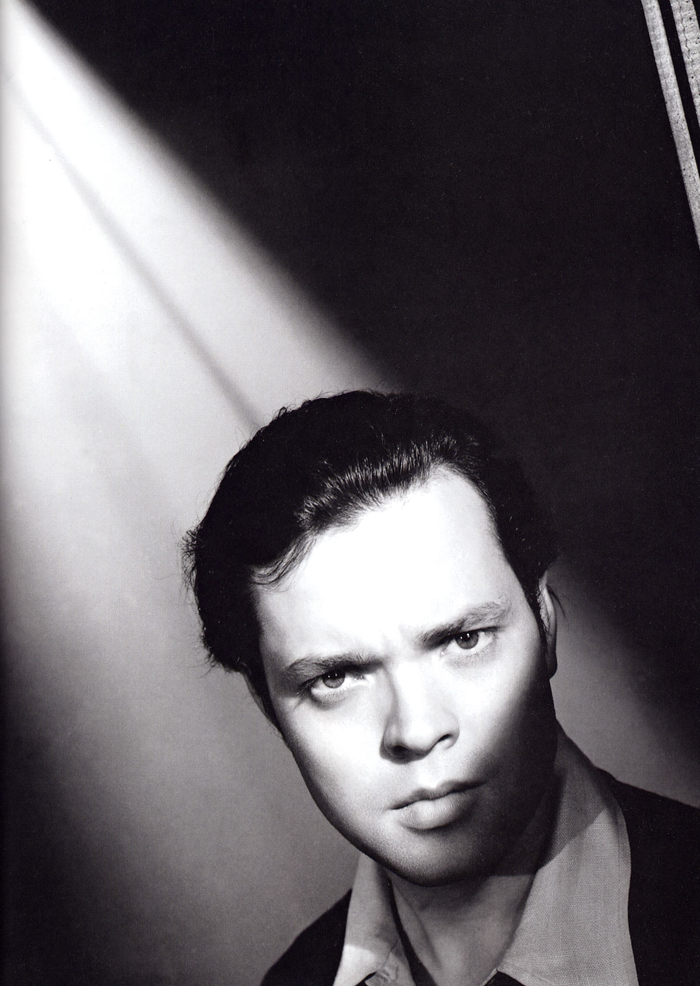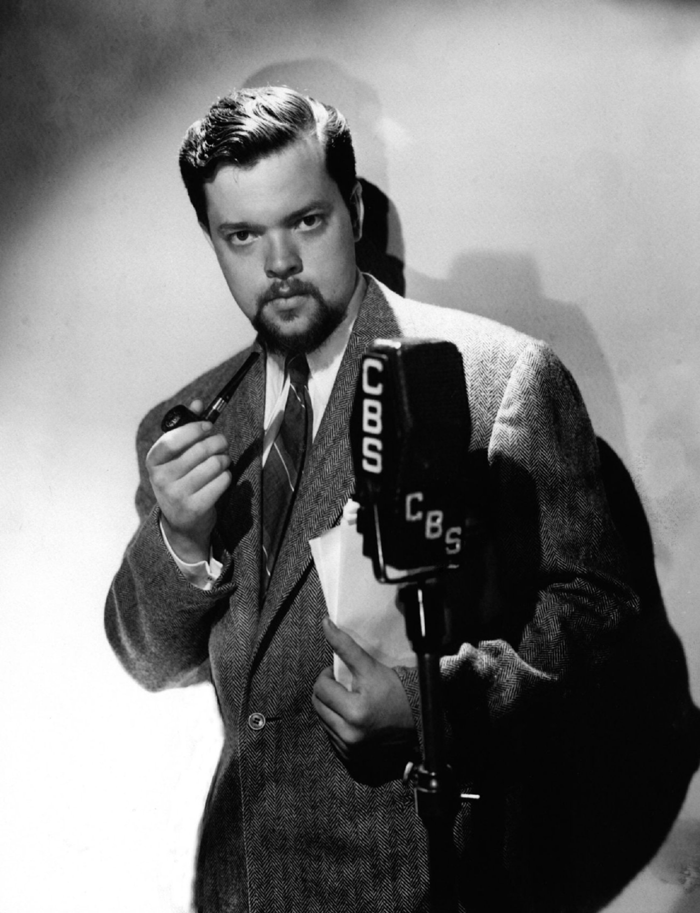American Film Institute Life Achievement Award: A Tribute to Orson Welles (1975)
1 DVD Total Playtime: 75 minutes

Each year since 1973, the American Film Institute have given their Lifetime Achievement Award to a prominent film star or director. (Always someone still alive at the time, who is willing to show up and give an acceptance speech.) The first two recipients were John Ford and James Cagney. In 1975, the third AFI Award went to Orson Welles, the first recipient honoured for his achievements as both an actor and a director. (Cagney directed one minor film, which wasn't mentioned during his AFI lovefest.)
An AFI tribute typically alternates between film clips from the work of the guest of honour, and testimonial speeches by Hollywood celebrities whose name value will bring in some TV ratings, even if they never worked with the recipient of the award. The Welles tribute features one actor who worked significantly with Welles throughout their separate careers (Joseph Cotten), and several actors who worked with Welles on only one occasion (Charlton Heston, Janet Leigh and Dennis Weaver from the cast of 'Touch of Evil'), plus some celebrities who (to the best of my knowledge) had never worked with Welles at all, including Ingrid Bergman and Frank Sinatra.
There are some excellent film clips here. Near the end of the evening, we are shown an extensive clip from 'Chimes at Midnight', Welles's film based on Shakespeare's Falstaff plays. The clip consists of several battle scenes, with men in armour clashing in a fog-dark forest, on foot and on horse; unfortunately, the scenes seem to be strung together with no connecting material, and the result is very confusing ... however, since real battles are usually confusing, this isn't necessarily a flaw in Welles's film. We also see Welles as Falstaff (or perhaps it's Welles's stunt double) galumphing about at the fringe of the battle, in a pot-bellied suit of armour that makes him look like a stove. Since we're seeing these scenes out of context, it's not clear if we're meant to laugh at this ridiculous figure.
Sinatra introduces the film clip of the famous climactic scene from 'Lady from Shanghai', featuring the shoot-out in the hall of mirrors. I've always considered this one of the greatest cinematic set-pieces of all time; by itself, it proves Welles's genius.
At the end of each AFI tribute, the guest of honour strides to the podium amidst a standing ovation and appropriate theme music. For Cagney, the music was 'Yankee Doodle Dandy'. For David Lean, the music was the 'Colonel Bogey March' which was used so famously in 'Bridge on the River Kwai'. What theme music is appropriate for Orson Welles? Answer: Sinatra sings a song more closely associated with himself, rather than with Welles ... 'The Lady Is a Tramp', but with new lyrics that really aren't very good. A typical line: 'He picked Cotten when nobody would, that's why the gentleman is a champ.' Afterwards, Welles rises to the occasion and speaks a few gracious words.
Each year since 1973, the American Film Institute have given their Lifetime Achievement Award to a prominent film star or director. (Always someone still alive at the time, who is willing to show up and give an acceptance speech.) The first two recipients were John Ford and James Cagney. In 1975, the third AFI Award went to Orson Welles, the first recipient honoured for his achievements as both an actor and a director. (Cagney directed one minor film, which wasn't mentioned during his AFI lovefest.)
An AFI tribute typically alternates between film clips from the work of the guest of honour, and testimonial speeches by Hollywood celebrities whose name value will bring in some TV ratings, even if they never worked with the recipient of the award. The Welles tribute features one actor who worked significantly with Welles throughout their separate careers (Joseph Cotten), and several actors who worked with Welles on only one occasion (Charlton Heston, Janet Leigh and Dennis Weaver from the cast of 'Touch of Evil'), plus some celebrities who (to the best of my knowledge) had never worked with Welles at all, including Ingrid Bergman and Frank Sinatra.
There are some excellent film clips here. Near the end of the evening, we are shown an extensive clip from 'Chimes at Midnight', Welles's film based on Shakespeare's Falstaff plays. The clip consists of several battle scenes, with men in armour clashing in a fog-dark forest, on foot and on horse; unfortunately, the scenes seem to be strung together with no connecting material, and the result is very confusing ... however, since real battles are usually confusing, this isn't necessarily a flaw in Welles's film. We also see Welles as Falstaff (or perhaps it's Welles's stunt double) galumphing about at the fringe of the battle, in a pot-bellied suit of armour that makes him look like a stove. Since we're seeing these scenes out of context, it's not clear if we're meant to laugh at this ridiculous figure.
Sinatra introduces the film clip of the famous climactic scene from 'Lady from Shanghai', featuring the shoot-out in the hall of mirrors. I've always considered this one of the greatest cinematic set-pieces of all time; by itself, it proves Welles's genius.
At the end of each AFI tribute, the guest of honour strides to the podium amidst a standing ovation and appropriate theme music. For Cagney, the music was 'Yankee Doodle Dandy'. For David Lean, the music was the 'Colonel Bogey March' which was used so famously in 'Bridge on the River Kwai'. What theme music is appropriate for Orson Welles? Answer: Sinatra sings a song more closely associated with himself, rather than with Welles ... 'The Lady Is a Tramp', but with new lyrics that really aren't very good. A typical line: 'He picked Cotten when nobody would, that's why the gentleman is a champ.' Afterwards, Welles rises to the occasion and speaks a few gracious words.

Preface by Charlton Heston, Chairman of the American Film Institute:
The basic intention of the American Film Institute's Life Achievement Award was clear from the beginning: to recognize a career in film. As dictated by the Trustees, the primary criteria of the award are specific. The filmmaker chosen must have in some fundamental way advanced the art of film, and his work must be acknowledged alike by the general public, the critical and academic community, and by his professional peers. The careers of the award's first two recipients, John Ford and James Cagney, ideally fulfilled the standards set.
Our choice this year is Orson Welles. He is surely qualified to stand with his predecessors on this dais. In that context, it's interesting to note that he claims he prepared for his first film by "studying the work of the masters: John Ford, John Ford, and John Ford." The film was Citizen Kane. It's fair to say it has become a benchmark in world cinema, an achievement against which other films are still measured.
The first AFI award went to a director, the second to an actor. In Orson Welles, we honor both crafts. His phenomenal talent, unquenchable energies and unflagging enthusiasm have served him equally well on both sides of the camera. Indeed, they have now and then impelled him to function as producer, writer, designer, gaffer and make-up man, though to my knowledge he has never fallen off a horse for pay.
His achievements outside the cinema are memorable, as well. On stage, he's done everything from Shakespeare to sawing women in half. Early in his career he assembled an extraordinarily gifted company of actors, the Mercury Players, and featured them in a memorable series of plays.
At the same time he electrified the Golden Age of radio with the same actors in the Mercury Playhouse. He brought most of them with him to Hollywood, planting a whole patch of flourishing talents in film. Throughout his career, his energies, his talents, and the fields they've reached could be described as protean.
Perhaps one of his most significant contributions to film was his pioneering effort as what we now call an independent fiimmaker. In the Forties, when almost all production was still studio-based. Welles began making films entirely on location as a maverick independent, putting them together with spit, string, and chutzpah, blazing the trail for many filmmakers to follow. Happily, Orson Welles continues to pioneer.
We must mark the work we value while its makers are still with us, and it's also good to mark the work of a man who is still doing it. Orson Welles came to films young enough to be burdened with that uneasiest of labels, a 'Boy Wonder'. He's no longer a boy, but he's still a wonder!
Charlton Heston
Chairman
The American Film Institute
THE PROGRAM FOR A GALA SALUTE TO ORSON WELLES
Entrance of The Guest of Honor, Mr. Orson Welles
Welcome by Martin Manulis, Director, AFI West
Charlton Heston, Chairman, The American Film Institute
Frank Sinatra, Host
Guests:
Edgar Bergen and Charlie McCarthy Ingrid Bergman
Peter Bogdanovich Joseph Cotten
Janet Leigh Anthony Perkins
Dennis Weaver Natalie Wood Music by the Nelson Riddle Orchestra
Music by the Nelson Riddle Orchestra
THE QUALITY OF THIS VIDEO IS FAIR-GOOD
CLICK HERE TO LEARN MORE ABOUT OUR PRODUCTS
We guarantee delivery of your item. If your item doesn't get there or is damaged, please notify us and we'll reship for you.
FULL REFUND IF NOT SATISFIED
This product was added to our catalog on Saturday 12 October, 2013.
